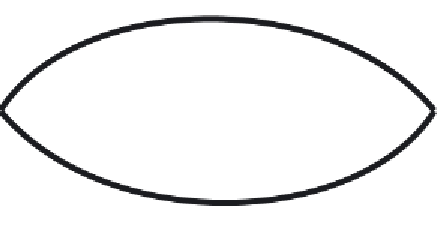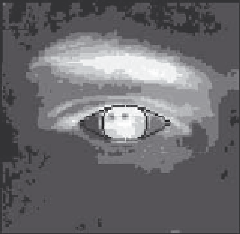Image Processing Reference
In-Depth Information
6.2
Deformable templates
One of the earlier approaches to deformable template analysis (Yuille, 1991) was aimed to
find facial features for purposes of recognition. The approach considered an eye to be
comprised of an iris which sits within the sclera (the white bit) and which can be modelled
as a combination of a circle that lies within a parabola. Clearly, the circle and a version of
the parabola can be extracted by using Hough transform techniques, but this cannot be
achieved in combination. When we combine the two shapes and allow them to change in
size and orientation, whilst retaining their spatial relationship (that the iris or circle should
reside within the sclera or parabola), then we have a deformable template.
The parabola is a shape described by a set of points (
x
,
y
) related by
a
b
2
ya
= -
x
(6.1)
2
where, as illustrated in Figure
6.1
(a),
a
is the height of the parabola and
b
is its radius. As
such, the maximum height is
a
and the minimum height is zero. A similar equation
describes the lower parabola, it terms of
b
and
c
. The 'centre' of both parabolae is
c
p
. The
circle is as defined earlier, with centre co-ordinates
c
c
and radius
r
. We then seek values of
the parameters which give a best match of this template to the image data. Clearly, one
match we would like to make concerns matching the edge data to that of the template, like
in the Hough transform. The set of values for the parameters which give a template
matches the most edge points (since edge points are found at the boundaries of features)
could then be deemed to be the best set of parameters describing the eye in an image. We
then seek values of parameters that maximise
{
c
, , , , , } = max
abc
c
r
E
(6.2)
p
c
x y
,
xy
,
circle.perimeter,parabolae.perimeter
a
r
c
c
p
e1
c
p
p
e2
p
1
c
p
2
b
b
(b) Deformable template match
to an eye
(a) Eye template
Figure 6.1
Finding an eye with a deformable template
Naturally, this would prefer the larger shape to the smaller ones, so we could divide the
contribution of the circle and the parabolae by their perimeter to give an edge energy
contribution
E
e




































